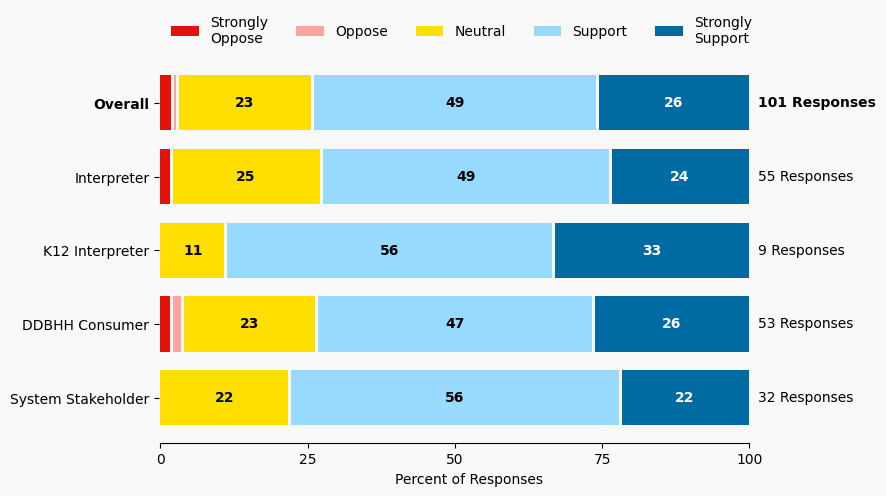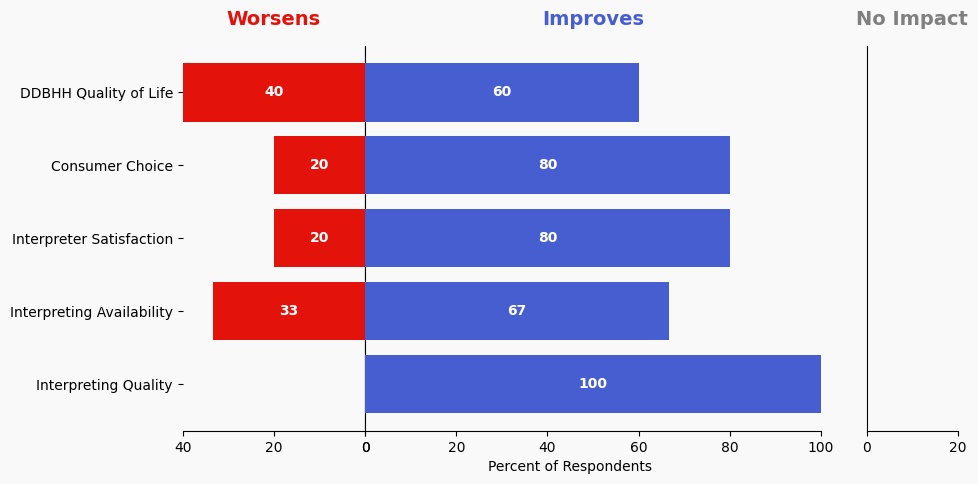70 MDE Promote NTID Course for Provisionally Licensed K12 Interpreters
Issue: Provisionally licensed K12 interpreters need resources for flexible professional development.
Proposed Solution: Minnesota Department of Education/Brightworks invest in this RIT/NTID Certificate in Educational Interpreting coursework for Minnesota’s K12 provisionally licensed interpreters.
Expected outcome: DDBHH students would have better educational outcomes; therefore, DDBHH students would be better educated citizens with higher employability. Improved support and job satisfaction for K12 interpreters and increased quality of K12 interpreting services.
Who is impacted: DDBHH children in mainstream educational settings, educational interpreters
Timeline: 6 months
Note: MDE may already make this coursework accessible to K12 interpreters; recommend providing more awareness, support and added compensation for interpreters to take advantage of this course.

Summary of Support Image Description
The stacked bar charts show how respondents rated their level of support and the total number of responses. The percentage for the five support levels is shown from left to right: Strongly Oppose (Dark Red), Oppose (Light Red), Neutral (Yellow), Support (Light Blue), and Strongly Support (Dark Blue).
Respondents may identify with multiple subgroups. The overall level of support is:
Overall
Strongly Oppose: 2%
Oppose: 1%
Neutral: 23%
Support: 49%
Strongly Support: 26%
Click to see the detailed image description for each subgroup.
Interpreter
Strongly Oppose: 2%
Oppose: 0%
Neutral: 25%
Support: 49%
Strongly Support: 24%
K12 Interpreter
Strongly Oppose: 0%
Oppose: 0%
Neutral: 11%
Support: 56%
Strongly Support: 33%
DDBHH Consumer
Strongly Oppose: 2%
Oppose: 2%
Neutral: 23%
Support: 47%
Strongly Support: 26%
System Stakeholder
Strongly Oppose: 0%
Oppose: 0%
Neutral: 22%
Support: 56%
Strongly Support: 22%
Overview of Respondents Opting for In-Depth Solution Analysis
After indicating their support level, 2% of the 101 respondents opted in to further assess whether the solution would worsen or improve on five metrics. Of the opt-in reviewers (3 respondents), 33% supported the solution, 33% were neutral on the solution, and 33% opposed the solution.
The remaining 98 respondents did not opt in to further assess the solution. Of these people, 75% support the solution, 22% were neutral on the solution, and 2% opposed the solution.
Reviewer Evaluation of Solution Effectiveness

Solution Effectiveness Image Description
The stacked bar charts show how respondents assessed the effectiveness of this solution based on five metrics. For each metric, the percentage of respondents is shown from left to right: Worsens (Red), Improves (Blue), No Impact (Gray).
DDBHH Quality of Life
Makes It Worse 40%
Makes It Better 60%
No Impact 0%
Interpreter Satisfaction
Makes It Worse 20%
Makes It Better 80%
No Impact 0%
Consumer Choice
Makes It Worse 20%
Makes It Better 80%
No Impact 0%
Interpreting Availability
Makes It Worse 33%
Makes It Better 66%
No Impact 0%
Interpreting Quality
Makes It Worse 0%
Makes It Better 100%
No Impact 0%
Reviewer Feedback and Insights
Interpreter
Comments from Interpreters raise questions about whether MDE could promote other educational specialty programs and whether NTID accepts Deaf applicants. One suggestion advocates for integrating ASL interpreters into teacher unions to push for paid internship programs.
Deaf, DeafBlind, Hard of Hearing
One comment from DDBHH Consumers expresses concern that RID expectations have negatively impacted the situation, with a suggestion to provide BIPOC interpreters more accessible certification options.
System Stakeholder
One comment from a System stakeholder indicates that this would be a good solution if grant funding support is available to offset costs, as school districts are already facing ficial strain.
PREVIOUS SOLUTION
69 Create Roster of Interpreters Qualified to Work in K12
Issue: There is no public roster of Certified Interpreters qualified to work in K12 educational settings.
NEXT SOLUTION
Issue: School districts operate differently when hiring K12 interpreters, resulting in a lack of standards and quality control.
Leave a Reply